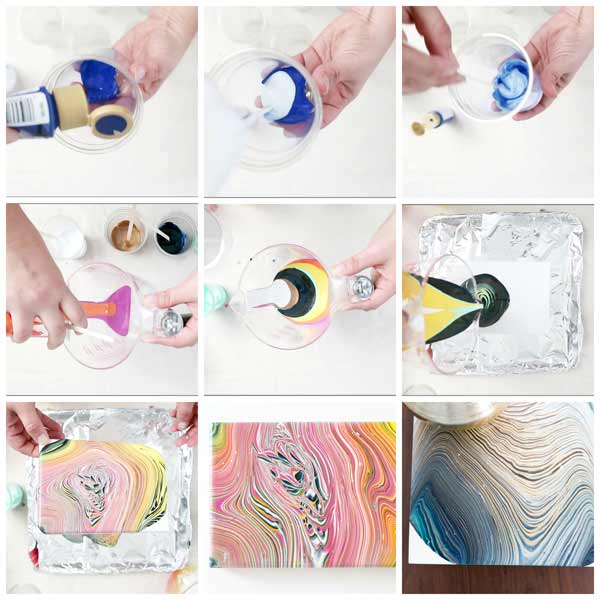All of us have a little free time. We don’t have it enough even during weekends when we
do not work. And the truth is that each of us, more or less, spend it in the same way. Coffee
with friends, reading books, slow walk.
Have you thought how you could spend that time and be creative? We mainly leave creativity  to those who are gifted, and for that reason we do not even try to do some things. Painting with acrylic colors is just proof for the opposite, because you do not need a talent for painting and drawing to make a piece of art!
to those who are gifted, and for that reason we do not even try to do some things. Painting with acrylic colors is just proof for the opposite, because you do not need a talent for painting and drawing to make a piece of art!
And what is needed, if not a talent 🙂 ? Canvas and various acrylic paint. In addition, you surely have everything else at home, especially if you have children. A pair of transparent, thin, rubber gloves (that can be the surgical ones that can be bought in any pharmacy, it’s
only important that those are not bulky but to stick to the hand), a few plastic glasses for each color separately, one bigger plastic glass in which you will mix colors if you like, a cake spatula (preferably plastic) or a brush for rolls coating (preferably a silicone one), and a small metal colander (such as the one for tea for example).
There are many techniques and ways of working with acrylic colors, and we will describe some of those. It will surely come to you, while reading this text or during the process of “painting”, something else you could try about this. So, try it, because you cannot really make a mistake here – there is no wrong and right way of drawing. This can also be a good and interesting idea for relaxing and entertaining employees!
Pouring acrylic colors on canvas
 It’s the best to do this activity on the terrace or in the garden, but if you do not have one, you can also make use of a dining table with an oilcloth on, the best an old one, to protect it. Pour a different acrylic color in each plastic glass, by your choice. It is best to put a baking oven grill beforehand, and a canvas onto it then, so that any excess of paint can leak from the canvas without losing the whole canvas. And if you want, you can also pour several different colors, one over the other, with or without subsequent mixing, together in one glass. If it turns out that the color is too thick, feel free to add some water to dilute it. Let’s say the density should be like the mixture you prepare for pancakes. When you decide on the colors to use, lightly pour them onto the canvas. The color should be spilled by inertia, and you can, if desired, direct it – up, down, left, right. It’s only important that you do it slowly and not abruptly. You can wipe the surface of the canvas with a spatula for cakes or brush for rolls coating while the color is still fresh or make some shapes. Or you can dip them in a different color and apply it over. Whatever. Let the inspiration you get at the moment lead you!
It’s the best to do this activity on the terrace or in the garden, but if you do not have one, you can also make use of a dining table with an oilcloth on, the best an old one, to protect it. Pour a different acrylic color in each plastic glass, by your choice. It is best to put a baking oven grill beforehand, and a canvas onto it then, so that any excess of paint can leak from the canvas without losing the whole canvas. And if you want, you can also pour several different colors, one over the other, with or without subsequent mixing, together in one glass. If it turns out that the color is too thick, feel free to add some water to dilute it. Let’s say the density should be like the mixture you prepare for pancakes. When you decide on the colors to use, lightly pour them onto the canvas. The color should be spilled by inertia, and you can, if desired, direct it – up, down, left, right. It’s only important that you do it slowly and not abruptly. You can wipe the surface of the canvas with a spatula for cakes or brush for rolls coating while the color is still fresh or make some shapes. Or you can dip them in a different color and apply it over. Whatever. Let the inspiration you get at the moment lead you!
And you can try this, too
In one plastic glass, slowly pour the paints, one over the other, without any additional mixing. If you want to use more colors or shades, pour as little portions as possible. Our suggestion is that after adding two to three colors, put in a little bit of white, and then continue pouring the next two to three colors and so on until you finish it. At the center, or where you want, place a small metal colander and gently pour the content from the glass. Let the colors flow through the holes. The extra color will automatically slip onto the oilcloth, and in order to cover the entire surface of the canvas, you can slightly focus on the color, as we explained in the paragraph above, and it will spread in concentric circles. With your hands, with the gloves on!, you can smear the excess on the edges of the canvas, where necessary, to cover the whites, if you do not want them to be there. Another idea: take a piece of transparent, self-adhesive kitchen foil, which is not a too large, and crumble it just a little bit. While the color is still fresh, tap the foil over it. The colors will be even more mixed and you will get a variety of different, abstract and wavy shapes. You can do all this on a vinyl board instead of a canvas. The techniques are the same. Your “masterpiece” should be completely dry in three days, and then you can hang it on the wall or put it in the place you’ve planned for it.
The third way
Before you decide to clean your oilcloth of excess colors that have been drained, and throw away the remains of paint from plastic glasses, we will tell just STOP! 🙂 You can use all of these for a new picture, and here comes how you can do it. The excess of the color left behind you should pour onto the oilcloth and mix it with the rest of the color that is already on it. Take the canvas and dip it therein with its “face” side. Then “rub” it and move into various directions. When you raise it, you will see that you will get very interesting shapes and tones. Perfectly imperfect picture! And don’t you worry, acrylic colors are easy to be
removed from the oilcloth 🙂 . Sprinkle the sponge with water and some cleaning agent, diluent or ethyl acetate and wipe it. If you are planning to perform this activity in the company you are working in, here are some suggestions what to do with the pictures. Organize a corporate exhibition or an auction, and donate all the money for charity. Or you can give those to a humanitarian organization, a place for homeless children, a hospital or a national kitchen.
Like in anything new you try, you may not immediately get the expected results. But do not feel discouraged! Instead, try again and again and again. And yet again. Include your family members or friends in this fun activity. Children will be especially pleased with it. Enjoy and have fun! And remember that practice makes perfect 🙂





































 Srpski
Srpski English
English